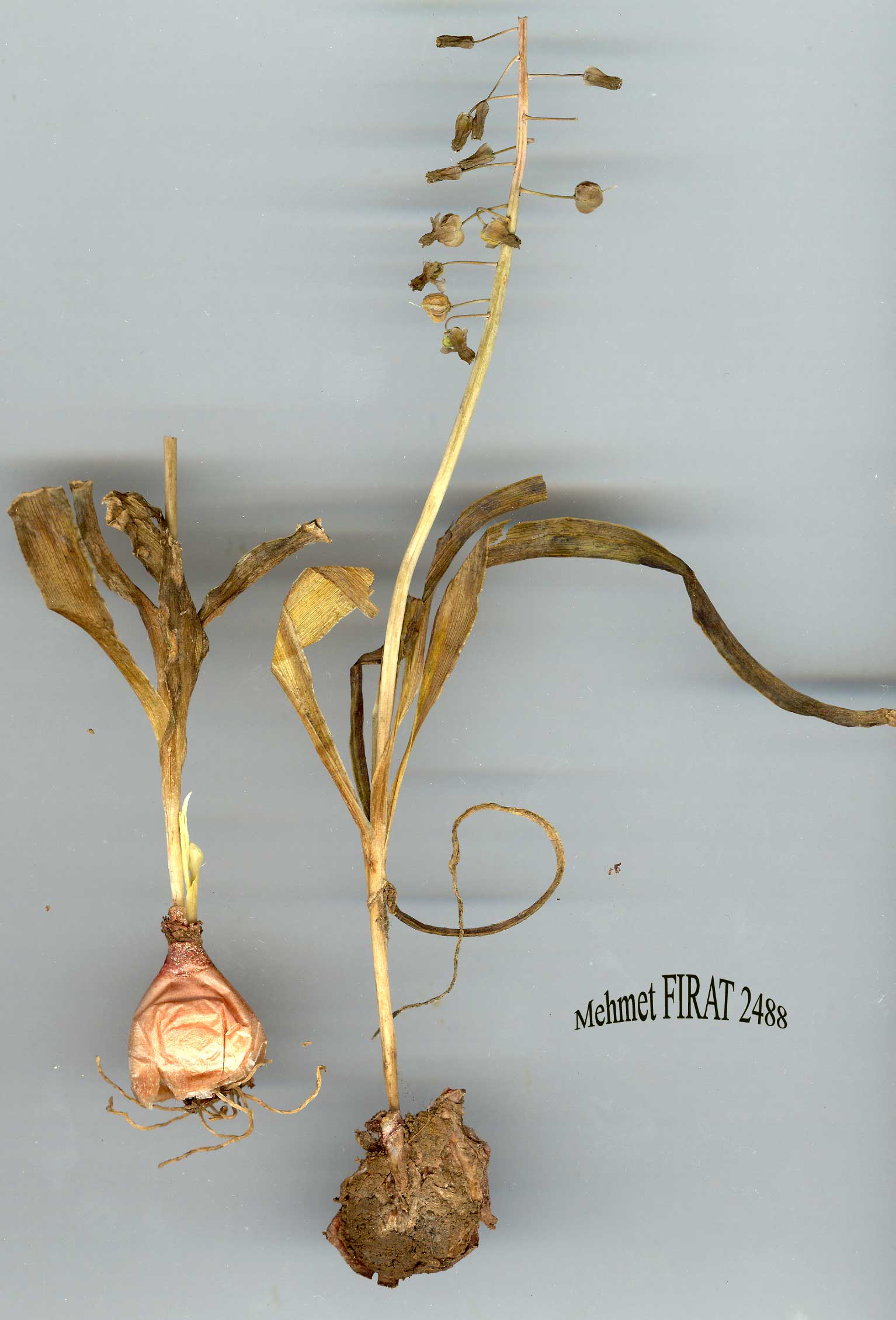| Liliaceae |
|---|
Muscari longipes BOISS. |
 Muscari longipes BOISS. |

Muscari longipes BOISS. |

Muscari longipes BOISS. |
 Muscari longipes BOISS |
 Muscari longipes BOISS |
Muscari longipes BOISS |
 Muscari longipes BOISS |
Muscari MILLER |
M. longipes Boiss., Diagn. ser. 1(13):36 (1854). Syn: M. albicaule Post, Pl. Post. 1:13 (1890)! M. aaronsohnii Opphr. & Beauv. in Bull. Soc. Bot. Geneve ser. 2, 22:278 (1931)! Leopoldia longipes (Boiss.) Los.-Los. in F1.ÜRSS 4: 410 (1935)! M. buschiricum Parsa var. pumilum Parsa in Kew Bull. 1949:35 (1949)! M. dinsmorei Rech. fil. in Ark. Bot. ser. 2, 1:507 (1952)! M. desert-icolum.Rech. fil. in Ark. Bot. ser. 2, 5:87 (1960)! M. atropatanum Schchian, nomen! Ic: Bull. Soc. Bot. Genève ser. 2, 22:279 f. III (1930), as Af. aaron-sohnii. Map 39. Buib 1.5-4 cm diam.; tunics ivory or pale pinkish. Leaves 3-9, usually twisted or circinnate, linear, 15-50 x 6-32 mm, acute, canaliculate, ±glaucous. Scape 20-60 cm (rarely more). Raceme lax, 6-50 cm x 5-30 mm, 80-200-flower-ed. Pedicels of fertile flowers patent or recurved (position often distorted by pressing), much longer than perianth, elongating after fertilisation to 50-80 mm to form a tapering oblong to conical inflorescence. Fertile flowers slightly nodding (in vivo), oblong-conical, 7-12 mm, lower 2/3 of tube beige or mauvish-brown, shoulders sharply angled and dirty white to beige, abruptly constricted above shoulders; lobes blackish. Pedicels of sterile flowers spreading or deflexed, as long as to much longer than the violet, closed, narrowly obovate-oblong sterile flowers. Capsule ovate-elliptic, 9-10 x 5-6 mm, acute. FL 4-6. Calcareous steppe, ravines, fallow fields, 550-1525 m. Type: [Palestine] in arvis pinguibus Palaestinae littoralis calidioribus ad meridiem urbis Gaza sitis et in regione Philistaeorum ad septentrionem ejusdem urbis, Boissier (holo. G!). Inner Anatolia. A3 Ankara: d. Beypazarı, Aladağ vadisi, 700 m, Akman 858! A4 Ankara: Çubuktal nr Ankara, 20 v 1932, Kotte! A5 Kastamonu: Tosya, Kavakçesme, Sint. 1892:4014! A6 Sivas: 24 km from Suşehri to Zara, 1520 m, Apold et al. 35b! B4 Ankara: Dikmen Da. S. of Ankara, 12 v 1942, Romieux (Hb. Hub.-Mor.)! B6 Sivas: 11 km E. of Sivas, 16 vi 1939, Reese (Hb. Hub.-Mor.)! B7 Tunceli: Pertek to Tunceli, 42 km from Elaziğ, 1400 m, D. 29112! B8 Muş: Muş, T. Baytop (cult. K)! C6Gaziantep: Aintab (Gaziantep), Haradj. 1304 (type of M. haradjianii Rech. fil.)! Urfa: 10 km N.W. of Birecik, 550 m, Sorger 80-8-32! C8 Mardin: 12 km from Gercüş to Hasankeyf, 700-800 m, D. 43053! Transcaucasia, W. Syria, Syrian Desert, N. Iraq, Iran. Ir.-Tur. element. A very variable species, most of the Anatolian material being different in habit and measurements to that from Palestine. lt is sometimes difficult to draw a line between this species and M. tenuiflorum, especially in S.E. Anatolia and W. Iran. The twisting of the leaves characteristic of M. longipes is not always expressed on the deep soil of cultivated or fallow fields. |